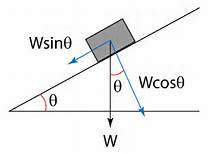A block weighing #15 kg# is on a plane with an incline of #pi/3# and friction coefficient of #1/10#. How much force, if any, is necessary to keep the block from sliding down?
2 Answers
The force is
Explanation:

Resolving in the direction parallel to the plane
Let the force necessary to keep the block from sliding down be
The force of friction is
The component of the weight is
Therefore,
Explanation:
I'll assume that
We're asked to find if any force is required (and if there is, what is it) to keep the block stationary and prevent it from sliding down.
We have our relationship for the friction force

Here,
The normal force
The quantity
This represents the maximum static friction force that prevents the object from sliding.
Taking the positive
Since this number is greater than the allowed static friction force of
This force is
directed up the incline.

